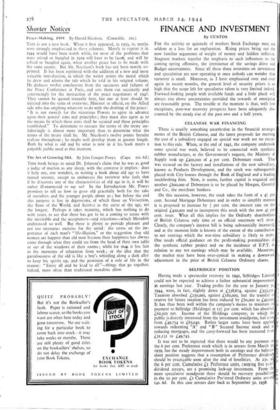FINANCE AND INVESTMENT
By CUSTOS FOR the activity or quietude of markets Stock Exchange men are seldom at a loss for an explanation. Rising prices bring out the now familiar arguments of weight of money and hidden inflation. Stagnant markets transfer the emphasis to such influences as the coming spring offensive, the imminence of the savings drive and Budget uncertainties. Since all these three restraints on investment and speculation are now operating at once nobody can wonder that turnover is small. Moreover, as I have emphasised over and over again in recent months, the general level of security prices is so high that the scope left for speculative talent is very limited indeed. Forward-looking people with available funds and a little pluck will always rise above uncertainties provided the rewards of enterprise are reasonably great. The trouble at the moment is that, with few exceptions, post-war recovery prospects have been adequately dis- counted by the steady rise of the past two and a half years.
CELANESE WAR FINANCING There is usually something unorthodox in the financial arrange- ments of the British Celanese, and the latest proposals for meeting the cost of a subsidiary engaged on special war work are no excep- tion to this rule. When, at the end of 1941, the company undertook some special war work, believed to be connected with synthetic rubber manufacture, at the Government's request, the Ministry of Supply took up £400,000 of 4 per cent. Debenture stock. This was secured on the factory and installations of the new subsidiary, known as Products Development, and the stock was subsequently placed with City houses through the Bank of England and a leading stockbroking firm. Now, it seems, further capital is required and another £600,000 of Debenture is to be placed by Morgan, Grenfell and Co., the merchant bankers.
On this occasion, however, the stock takes the form of a 41 per cent. Second Mortgage Debenture and in order to simplify matters it is proposed to increase by 1 per cent, the interest rate on the original £400,000 and to incorporate this stock with the new 41 per cent. issue. What all this implies for the Ordinary shareholders of British Celanese only time or an official statement will show. Clearly, the company's interest bill is being substantially increased, and at the moment little is known of the extent of the contribution to net earnings which the war-time subsidiary is likely to make. One needs official guidance on the profit-making potentialities of the synthetic rubber project and on the incidence of E.P.T. id relation to any net earnings which may be available.' Meantime, the market may have been over-cynical in making a downward adjustment in the price of British Celanese Ordinary shares.
SELFRIDGES' POSITION
Having made a spectacular recovery in 5942, Selfridges Limited could not be expected to achieve a futher substantial improvement in earnings last year. Trading profits for the year to January 31, 1944, were, in fact, slightly down at £338,674, against £353,511. Taxation absorbed £23o,000, against £18o,000, but the transfer to reserve for future taxation has been reduced by £6o,000 to L40,000 It has thus been well within the company's means to maintain its payment to Selfridge (Holdings) at 521 per cent. which has absorbed £62,50o net. Income of the Holdings company, in which the public is directly interested from the investment standpoint, has risen from £49,754 to £63,040. Rather larger sums have been applied towards redeeming "A" and " B " Secured Income stock and in reducing mortgages, and the carry-forward has been increased from £31,131 to £49,743.
It was not to be expected that there would be any payment on the 6 per cent. Preference stock which is in arrears from March 31, 1939, but the steady improvement both in earnings and the balance- sheet position suggests that a resumption of Preference dividends should be practicable soon after the end of hostilities. At 23s. the 6 per cent. Cumulative 41 Preference units, carrying five years' dividend arrears, are a promising lock-up investment. From more speculative standpoint there should be recovery possibiliti in the so per cent. Ls Cumulative Preferred Ordinary units aro 14s. 6d. In this case arrears date back to September 30, 5938.


























 Previous page
Previous page